Amritsar -
Haridwar -
Rishikesh -
Manikaran -
Pushkar
Bombay -
Goa -
Hampi -
Dharamsala -
Gorakhpur
| |
|
|
Goa was occupied by the Portuguese for 450 years and Portuguese-style buildings and churches along with Hindu-temples coexisted peacefully throughout the city.
Jesus meets Shiva
Photo by Ruff Libner (Trav.didje.)
Less peaceful were the beginnings of Christianity here. Conquered as a strategically important harbour and Christianized by force, Goa became a small Christian enclave at the West coast of India.
It's a place of heavenly silence. Many Indians recover here from their loud and aggressive everyday life in the big cities. According to an old Hindu legend, already the Gods were taking vacations here. Now, sun-seeking and freedom-loving freaks from all over the world had found their paradise here.
From Panaji I took a coach to the Anjuna beach. Most people here lived in self built huts or had rented a room, and it was here that the full moon parties were celebrated.
|
|
Travelling didjeridoo

|
| |
Little South Anjuna
Photo by Bernhard Leyendeckers - 1985
|
|
Bernhard Leyendeckers

|
| |
South Anjuna
Photo by Ian Watkinson - 1975
In search for an accommodation I witnessed the preparations of the weekly flea market. Some burn-offs spread out their last belongings for sale. Among them also Antoine and Chantal, which I left in Herat. They sold their souvenirs and were on the way to the French Embassy in Bombay. I gave them a small piece of Charas to sweeten their sad circumstances. Others sold Chai or self-made jewellery. One found beautiful objects and rarities from the Himalayas and of course also ominous Charas.
Because I urgently had to fill up my travel budget, I bought a small scale from a Frenchman who had just sold his last gram of Manali. I had left Steve's simple scale behind in the mountains. I still had the silver rupees, but now they weren't used as a unit any more. Most dealers obviously had Manali on tab. A real nut was running around with a Samsonite suitcase, filled with small quantities of Thai gras, Afghani, Pakistani, Nepali and more. The word about my exceptional Manikaran spread quickly and it was one of the best on the market.
|
|
Ian Watkinson

|
| |
Anjuna market
Photo by Jonathan D. Benyon - 1976
The market was not only an opportunity to trade, but also the weekly meeting place where one met old and new friends. Newcomers were welcomed, and others were bid farewell. I made friends with Thorsten from Hamburg who was exalted about Arambol. I did not feel so comfortable at the Anjuna beach! It was overcrowded and several very beat-up junkies were hanging around and thus I accepted the invitation of Thorsten with pleasure. In the afternoon we started northwards.
|
|
Road to Goa

|
| |
Vagator
Photo by Robert Fraisl
On the hill of Vagator we saw Jonathan's Silver Express. In London he started his 'Road to Goa' with 2 passengers. Then in Istanbul his coach filled and some joined in Teheran, Kabul or Delhi. This was a comfortable and relaxed alternative to the local transportation.
|
|
Robert Fraisl
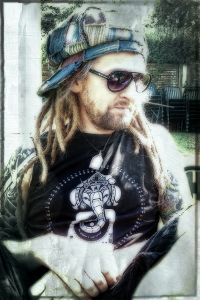
|
| |
Vagator-hill with Jonathan's Silver-Express
Photo by Jonathan D. Benyon - 1976
We spent the night in Chapora in front of a cave in which Ian from Jamaica had lodged. Lush green covered the grotto, and it was said that a snake also lived here. Therefore only a few dared to enter it and nobody wanted to spend the night here. It might have been just what Ian had intended. During the day it was pleasantly cool here and at night candles created a fantastic scenery.
Shortly after sunrise we went up to the Chapora fortress. From here you've got a fantastic view over Vagator to Anjuna in the south and over the Chapora river in the north.
|
|

|
| |
View southwards
Photo by Robert Fraisl
|
|

|
| |
View northwards
Photo by Bernhard Leyendeckers - 1972
We crossed the river with a small ferry. On our tour we only met friendly fishermen and after some hours Arambol announced itself with bizarre rock formations. We ran barefoot over the craggy stones which the sea had sharpened. During the following months I badly hurt my feet at this place several times.
|
|

|
| |
Rugged rock fromations of Arambol
Photo by Ruff Libner (Trav.didje.)
Before us was a lonesome beach and a small lake. We heard 'Bom Shiva' from the other end of the beach.
|
|

|
| |
Arambol
Photo by Sunny Schneider - 1976
Under a shady ledge a small group of Germans and French welcomed us. Among them was also Kai, a friend of Thorsten and the joy of meeting again was great. I entrusted Thorsten with my backpack and went to the lake.
|
|
Sunny Schneider
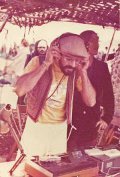
|
| |
Arambol lake
Photo by Ruff Libner (Trav.didje.)
I followed a small brook right into the jungle and the chant of birds and the screaming of monkeys mixed with the rhythm of drums.
|
|

|
| |
Arambol - along the stream
Photo by Lichtfaktor
The brook lost itself and I stood under a gigantic Banyan tree.
|
|
Lichtfaktor
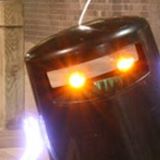
|
| |
Banyan tree
Photo by Ruff Libner (Trav.didje.)
A small group of Italians welcomed me somewhat cautiously into their retreat. I conjured up a small Charas-Nugget - and the ice was broken.
"Wow!... really good Charas! From where?"
"Manikaraaaan!" I sang out into the jungle and "Welcome!"
it echoed promptly back! Flabbergasted I saw several hermits stepping out of the bushes and quickly their glowing Chillums bore testimony to a sworn in community. One dozen seekers had withdrawn here.... far away from the bustle and from the excessive parties. Somebody retold a Datura trip:
"I was awoken by the cold water and it seemed like I was on a time journey. During the monsoon the brook becomes a river."
Someone else spoke about a French guy who had jumped to his death off a cliff during a Datura trip in Vagator.
"Don't tell anybody of this place if you are back to Anjuna!" they shouted!
In a quiet mood I wandered through the primeval forest and had a vision: blustering water gargled through the jungle and the luminous eyes of a small skull was fixating me.
|
|

|
| |
|
Arambol during the monsoon season
Photo by Ardian Fu - Demonfright by Chris De Bié
The warning about Datura made me pensive and I went back to the beach. The next day I got a few braided palm twigs in the village and built a small hut on the slopes of the hills in which the brook was embedded. Equipped with some food and cooking equipment I spent many weeks in the jungle. During the days I collected wood and refilled the water supply and in the evening I sat beside the fire and listened to the jungle concert. Sometimes I heard a flute which I then accompanied with my bongo.
I could have spent the rest of my life in this oasis of quietude but I had to earn a living and I made my way back to Anjuna. In Chapora I met Ian again who told me about a baker for whom he had sold cookies once.
"Apple-pastries for the Anjuna market! That's it!"
I shouted enthusiastically and embraced him.
The baking room was situated a few kilometres away from Chapora and the coast. The baker was very attracted to my idea and suggested to look around at the market in Mapusa to procure the ingredients.
|
|
Ardian Fu

|
| |
Mapusa Market - 1985
Photo by Bernhard Leyendeckers
It was a great pleasure to shop at this huge and colourful market. Among the many wares I discovered some yellow and brown cones. The light ones were made of sugar cane juice and the dark ones of palm juice which was cooked down to syrup and then left to cool until they became hard as rock. They were called jaggery. Upon recommendation of the trader I tried the palm-jaggery. To my delight there even were some wine stores here which sold some wine! And this is where also Coconut and Cashew Fenny was sold, a liquor made of coconut and cashew apples, for which Goa was famous. This was remarkable: in India alcohol is sold in so-called 'Wineshops', however, one searches wine there in vain. You only find rum, whisky and beer. Outside of Goa alcohol consumption in public is forbidden and this made the glass of Porto I drank whilst I observed the market a truly special event. I wrote down the recipe for the filling of the apple pastries:
3/4 of apples and 1/4 of mangos, palm-jaggery, raisins, cashews,
coconutmilk, ghee, cardamom and cinnamon.
The apples were delicious but also very expensive as they came all the way from Kashmir and the market people showed quite some surprise at the considerable quantities I bought. However I kept silent about my baking project. The baker was surprised as well once he saw the ingredients. He chopped up the hard Jaggery with a knife and I crushed the cardamom seeds in a mortar. In a big pot we heated the coconut milk and dissolved the jaggery in it. Then there came the chopped apples and mangos, ghee, cinnamon, cardamom, raisins and slightly roasted and crushed cashew seeds. On a small flame we left some 10 litres of this delicious mixture to simmer for a while.
"Food for the gods!"
praised the baker and mixed flour with ghee, salt and water.
"Yes, this is real ambrosia!" I replied beaming, kneaded the small piece of dough and rolled it out to 10 x 20 cm. I placed 2 or 3 tablespoons of filling on it and closed the pie by placing the corners on top of each other. The result was an approximately 6 by 12 cm pie which the baker coated with some Ghee. To my disappointment it was not baked immediately.
"Tomorrow I bake everything together !" he explained to me smiling with his bit of English.
"Maybe I make 150 pies out of it. How much money did you spend ?"
"25 Rupees !"
"OK, I pay you the 25 Rupees and you give me 50 Paisa for one pie. In Anjuna you can sell them for a Rupee!"
he suggested and paid the market bill. We sealed the business with a handshake.
"Do you you have a Basket ?"
“No !" I answered, a bit embarrased!
"No problem! I have one!" and rummaged for a big basket. I put the basket on my head and he asked smiling:
"Did you ever do this before ?"
"No!" and only then did I realize in what I had gotten involved.
"Tomorrow at 10 !" he told me laughing.
On my return to Chapora I anticipated the weight which I was going to carry soon. Ian and friends welcomed and congratulated me on the beach:
"This is a nice way to survive here! When I tried it, it was hard work and the cookies weren't that good. I'm really curious about your results." Ian said.
"If all goes well, I'll make 75 Rupiees. The equivalent of close to 7 grammes of my Manikaran."
"Now its worth even more: it went from 12 to 15 Rupees."
"Wow! Now it is as precious as silver. Let's smoke a Chillum on that!"
I exclaimed and gave Ian a small piece of my treasure. Then I shared my worries:
"I have to be careful with my money and my residence permit is expiring in a month."
"In Bombay there's an officer called Moses. For 100$ he'll extend your visa by 3 months. The stamps and the visa are authentic. It just doesnt happen in an office but in a cafe! Here, my friend! The honour to light this Chillum goes to you !" said Ian as the Chillum is usually lit by the one who stuffs it."
"Thank you for the tip, Ian. Aleeec !" I shouted and laid my hand behind my ear and my friends answered with a sounding
"Booom Shiva... Booom Shankar!". New guests provided the filling of the following Chillums.
At about 8 o'clock I got on my way. I was greeted by a delicious smell and the baker just pulled the last apple pies out of the stove. We tried one and were truly happy with the result.
"Very good! We'll make much money together! We have 150 pies!"
"I hope so." I replied, suddenly a bit unsure whilst I loaded the basket.
With 15 kg on my head I walked the 10 km via Chapora and Vagator to Anjuna. In Chapora I sold the first pies to Ian & Co. and in Vagator I found some more happy buyers. Thus my load decreased perceptibly and finally I reached Anjuna-Beach in the midday heat.
|
|

|
| |
Selling my apple-pastry
Photo by Jonathan D. Benyon - 1976
I sat down besides an Italian who sold Chai, covered the basket with a cloth and put some pastries on it. Then an Englishman joined us and took out his scale to sell his dope. We formed a perfect trader team: Tea to go with the pies and afterwards a Chillum. Within a few hours my basket was empty and 150 Rupees filled my pocket. Half of it went to the baker and so I had earned 75 Rupees - the equivalent of 8.3 dollars. On the following party I celebrated my success dancing to 'One of these nights' from the Eagles. I still remember
Santana's 'Stoneflower', 'Too high' from Stevie Wonder, 'Do it again and 'Show biz kids' from Steely Dan and 'Light my fire' from the Doors. Of course Pink Floyd's 'Dark side of the moon' was also often heard and this was probably the most-played music during those days in Goa. Even today one still can hear it in Goa next to the established Techno music. A relic from old times!
"Hey, mister Pastry Baker!" I was called! "Do you still have some of your good 'Manikaran'?"
"Yes, I do. But this is my whole capital and now I need 15 Rupees for a gramme."
"I understand, you wouldn't be selling apple pastries otherwise? However, it's really worth it. How much could I buy ?"
"Do you have dollars?"
"I do."
"OK, let's say 60 grammes for 100 dollars."
"All right !"
That was the visa! Somebody played 'Smiling faces sometimes' by Rare Earth over the PA:
"Smiling faces sometimes pretend to be your friend. Smiling faces show no traces of the evil that lurks within. They don't tell the truth!"
This should probably warn me about false friends and I will be more careful with whom I share my chillum. After all I had to sell 10 to 15 pies to fill one!
In Chapora I went to the fortress and heard screaming guitars and the refrain:
"Let's have a party - an Anjuna Full Moon Party."
|
|

|
| |
Anjuna Jam Band
The next day I prepared a modest place to stay in a tiny cave. I closed the entrance with braided palm twigs: a shady place in which I could spend the night on my weekly way to the baker. Even if the heavy basket had left a swelling on my head I was firmly determined to bring my sweets to the people until Christmas. As I became Mr. Pastry baker I got to know many people and it allowed me to discretely sell my charas.
In Arambol a nasty surprise awaited me: my crockery was scattered around and my hut had half collapsed. From a distance I heard monkeys who seemed to laugh at me.
"This will be a lesson!" I gasped out and heard some people laughing in response. During the next day I got me some bamboo and coconut fibre to reinforce my hut and to strap my stuff. I also met a neighbour who bought his fire wood. The locals had got this from our jungle some 3 km away and he dragged it now over the gruff stones all the way back. I could not suppress my laughter and the Indians had to grin as well. In the Chai shop I ate a Bhaji, a small dish made of peas and took some Ladoos, nutritious balls made of chickpea flour, copra (dry coconut), cashews, cardamom, condensed milk and sugar.
I spent the following weeks in Arambol with regular excursions to Anjuna and during this time the flea market became an attraction to many Indians who enjoyed to have a look at all these Hippies without buying anything. This was quite annoying to us and we changed the market date every week. Sometimes one could see Indians with binoculars behind the dunes. On no other beach in prude India could one see so much naked skin. My markets were very successful and at least every second freak had eaten some of my pastries over time and I had become somewhat of an institution for sweets and smokes!
By end of November I went on to Moses in Bombay. The café Ian had mentioned lay slightly hidden in the outskirts of the town. I drank some chai and watched attentively but slightly ill at ease the activities around me. Then the owner approached me and asked:
“Can I help you?”
“Yes, I am looking for Moses!”
“You're a bit early! Come back in an hours time! Place one hundred Dollars into your passport and hand it over to him discreetly!”
“Thank you! Could I get something to eat?”
“Across the road from here you can eat very well! Don't fret, all will be o.k. Moses is always dressed in white when he comes here!”
“Thank you, see you later!”
An hour later I saw him and returned to the café. He greeted me and I was invited to have some chai.
“Can I do something for you?”
“Yes!” and discreetly I handed over my passport.
“Do come back here tomorrow around the same time. I am Moses and I hold the key to the promised land!”
I could barely sleep, my insecurity kept me awake and was getting worse. What had I done! Handed over my passport and one hundred Dollars to a complete stranger! I could have travelled along the coast to Ceylon to obtain a visa there. In my situation however I did not want to apply this trick and I also did not want to leave Goa. Fortunately though, my worries were completely unfounded; I got my passport back the following day endowed with a 3 month visa! Relieved I took the boat back to Goa allowing myself some liberal helpings of delicious Port wine.
On December 6 - in parts of Europe St. Nicholas Day - I walked to Anjuna for my last Full Moon Party.
|
|

|
| |
Anjuna Full Moon Party
Here I met an American riding on a bike. He had a bottle full of liquid LSD with him.
"Stretch out your tongue and you'll take the trip of your life!" he told me smiling. I accepted with pleasure and thanked him by folding my hands and bowing my head.
|
|
![]()
|
| |
Sunset
Photos by Sunny Schneider - 1976-78
The sun said goodbye and we were welcomed by the moon.
|
|

|
| |
Moonrise
Photo by Ruff libner (Trav. didje.)
I shared this magnificent scene with many others who had also met St. Nicholas. We may have been more than hundred and everybody on the same wavelength!
|
|

|
| |
Goa Waves
Digitally enhanced fractal image by Mimulux
We bathed in and on the waves of an infinite ocean. Submerged by waves of love we danced like in trance through the night...
|
|
Ting Po
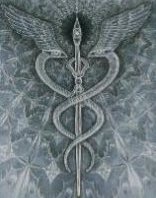
Mimulux

|
| |
During the night
Photo by Sunny Schneider - 1976
...until the silver moon sank into the sea...
|
|

|
| |
Moonset
...and the golden sun climbed up at the same time behind the palm-trees.
|
|
Chris De Bié
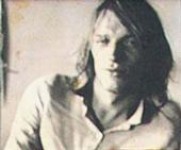
|
| |
Sunrise
Digital images by Chris De Bié
I had gone on some psychedelic trips, alone or with a few good friends, but this sense of community with so many people was a very unique experience.
Until Christmas I successfully continued selling my Applestrudel and after the New Year Party I and a few others were on our way to Hampi.
further
|
|
![]()
|
| |